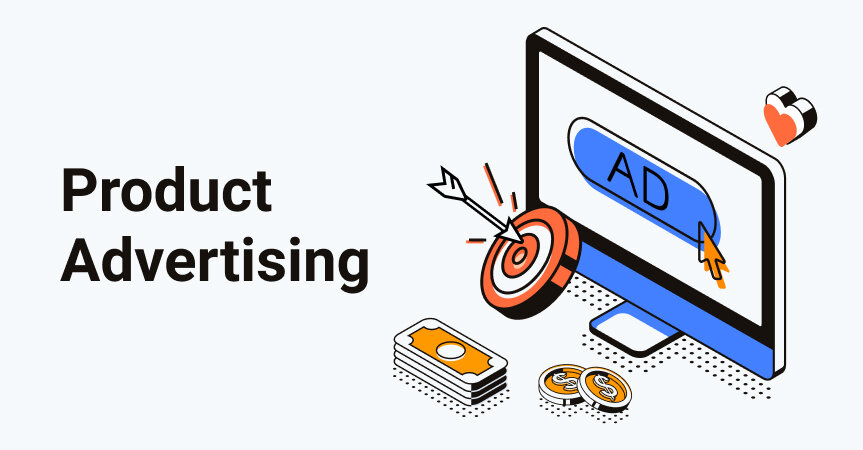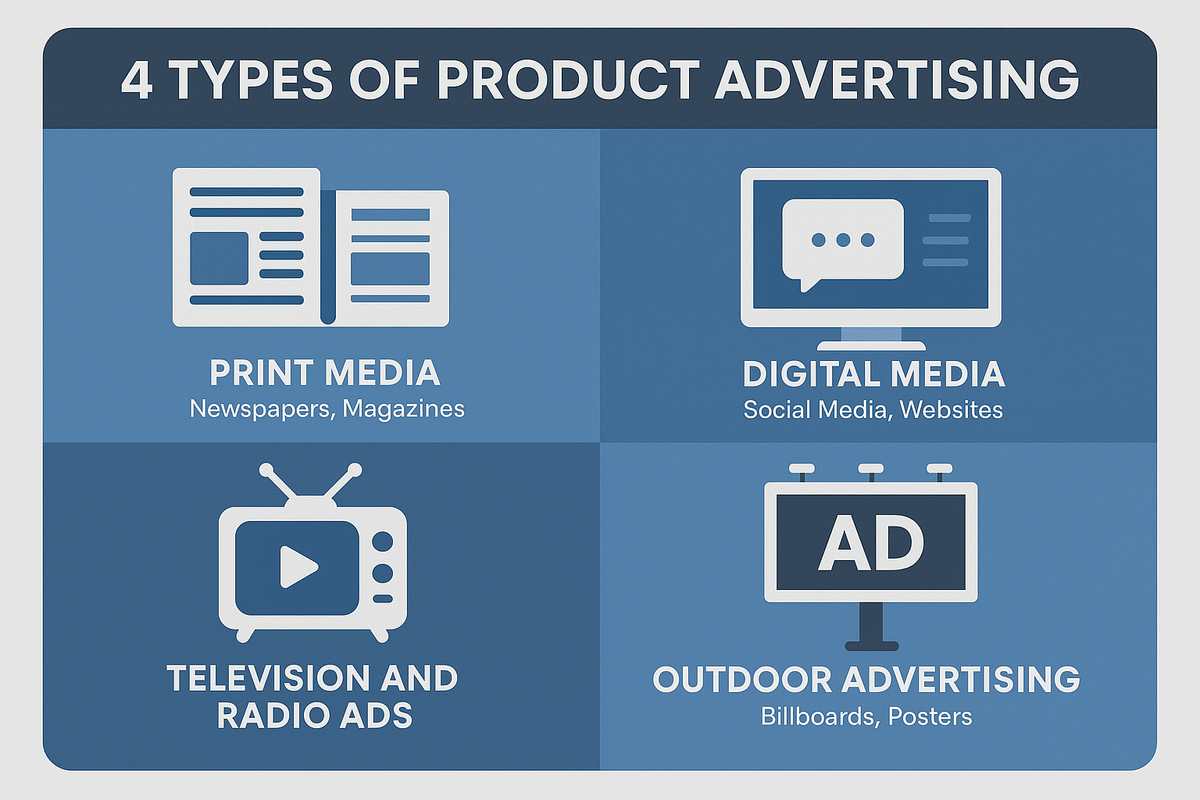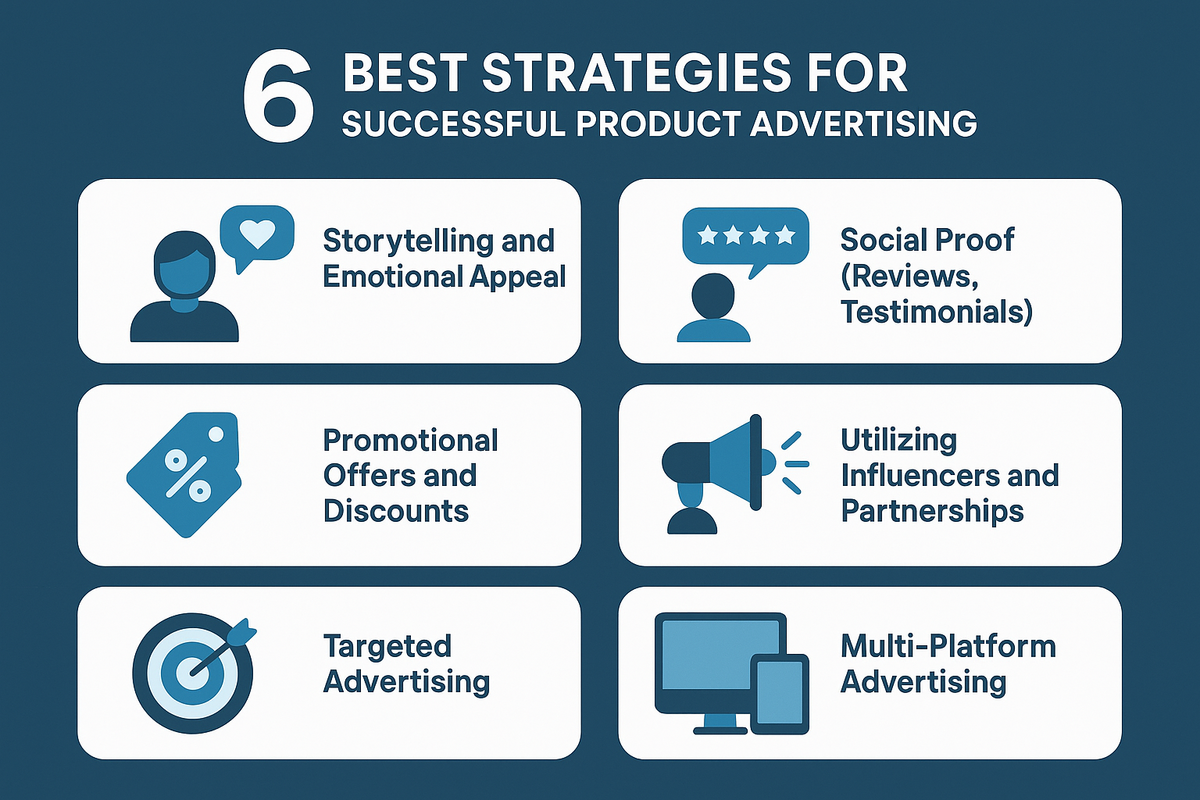So, what is product advertising?
It's a key marketing strategy designed to get your product in front of the right audience and drive sales.
Through a combination of media channels like TV, social media, print, and digital ads, businesses aim to create awareness, spark interest, and ultimately convince potential customers to make a purchase.
Therefore, highlighting a product's unique features and benefits, product advertising helps businesses stand out in a competitive market.
It builds brand recognition, boosts consumer trust, and plays a vital role in shaping how consumers perceive a brand.
In today’s crowded marketplace, investing in effective product advertising isn’t just about selling a product, it’s about creating lasting customer engagement and loyalty.
This blog explores how advertising of products can elevate your marketing strategy and drive success.
What is Product Advertising?
Product Advertising refers to the marketing strategy used to promote and create awareness about a product or service to potential customers.
The goal is to persuade and inform the target audience about the product’s features, benefits, and value.

It uses various mediums, such as television, radio, print, online platforms, social media, and more, to deliver compelling messages that encourage customers to make a purchase or take a desired action.
When evaluating online platforms for marketing, it’s worth considering the best website builders for small businesses, as these platforms can help streamline your online presence alongside product advertising efforts.
By understanding What are five marketing strategies that retailers spend half of their annual budget on? Retailers often focus on a combination of digital, television, print, social, and outdoor ads, aligning their budget with the channels that deliver the highest ROI.
4 Types of Product Advertising
Product advertising encompasses various strategies to promote products to target audiences.
These strategies include:

1. Print Media (Newspapers, Magazines)
Print advertising involves placing advertisements in newspapers, magazines, brochures, and catalogs. These print materials target specific demographic groups, making it a powerful tool for local and regional advertising campaigns.
Print ads can be highly effective for reaching an older, more traditional audience who still consumes print media regularly.
However, with the rise of digital media, businesses are also exploring innovative advertisement examples, combining traditional with modern approaches.
Additionally, print advertising helps build long-term brand credibility, as it has a certain level of trust among consumers.
Magazines and newspapers offer a way to reach readers who are engaged with the content, providing an opportunity for more thoughtful ad placement.
However, print advertising often requires a higher upfront cost, and tracking its effectiveness can be more challenging compared to digital alternatives.
Despite this, print media remains a vital advertising avenue, especially for businesses seeking to establish a strong local presence or promote high-end, niche products.
2. Digital Media (Social Media, Websites)
Digital advertising encompasses platforms such as social media (Facebook, Instagram, LinkedIn, etc.) and websites, which offer the ability to reach vast, diverse audiences online.
Social Ads on platforms like Facebook and Instagram are incredibly effective at targeting audiences based on user behavior and preferences.
The key strength of digital advertising lies in its ability to target very specific demographics based on user behavior, interests, geographical location, and browsing patterns.
What is the digital marketing strategy that tracks users across the web? Retargeting ads on various digital platforms can help businesses re-engage visitors who previously interacted with the brand.
This precision makes digital media particularly attractive for businesses seeking to maximize their ROI. Social media advertising, in particular, has the advantage of interactive, real-time engagement with users, enabling brands to foster a direct connection with their audience.
Moreover, digital ads can be easily modified or optimized for performance, allowing marketers to track metrics like impressions, clicks, and conversions for continuous improvement. This makes digital advertising a flexible, cost-effective option for brands looking to engage with a tech-savvy audience.
Explore Our Performance Marketing Services!
3. Television and Radio Ads
Television and radio ads are among the most traditional forms of mass advertising, with a broad reach across diverse audiences. Television ads are powerful for creating memorable visual and emotional connections, leveraging sights and sounds to create a lasting impact.
A well-crafted TV commercial can evoke strong emotions, raise brand awareness, and deliver a clear, persuasive message. However, television ads can be expensive, particularly during prime time, and may be less targeted compared to digital options.
On the other hand, radio ads are a more affordable option for reaching a broad audience, especially during peak listening times, such as during morning and evening commutes.
Radio advertising also allows for creative audio elements, such as jingles and voiceovers, to enhance brand recall.
Although both TV and radio ads allow for mass communication, they lack the precise targeting capabilities that digital ads offer, which may limit their effectiveness in some scenarios.
4. Outdoor Advertising (Billboards, Posters)
Outdoor advertising includes billboards, posters, transit ads, and other forms of out-of-home media placed in high-traffic locations such as highways, city streets, shopping malls, and public transport systems.
This type of advertising is highly effective for creating brand awareness and reaching consumers who are constantly on the move, especially in urban environments.
Billboards and posters are often large and eye-catching, making them ideal for showcasing bold messages, brand logos, and compelling visuals.
The key advantage of outdoor advertising a product is its constant visibility, these ads are typically viewed repeatedly by people commuting or walking through busy areas, which helps reinforce brand recognition.
However, outdoor advertising has limited space for detailed messages and lacks interactive engagement, unlike digital or social media ads. Additionally, tracking the effectiveness of outdoor ads can be challenging, making it harder to measure the exact impact.
7 Key Elements of Effective Product Advertising
Effective advertising of a product is crucial for capturing attention, building brand recognition, and ultimately driving sales.
These elements help to craft compelling ads that resonate with your target audience and effectively communicate the value of your product.
- Clear Messaging: Ensure the message communicates the product’s value and key benefits in a straightforward manner.
- Target Audience Identification: Tailor the advertising to meet the needs, preferences, and pain points of the intended audience.
- Compelling Visuals: Use engaging visuals, such as images or videos, to capture attention and highlight the product’s appeal.
- Strong Call-to-Action (CTA): Encourage immediate action, whether it’s a purchase, sign-up, or more information.
- Brand Consistency: Maintain a consistent brand tone, style, and colors across all advertising platforms.
- Social Proof & Testimonials: Showcase customer reviews or endorsements to build credibility and trust.
- Urgency & Scarcity Tactics: Create urgency through limited-time offers or scarcity to prompt quicker customer action.
By focusing on these elements, businesses can create powerful advertisement of product that engage their audience, encourage conversions, and strengthen brand loyalty.
Additionally, how to search a word on a website plays a key role in ensuring your product ads are easy to find by consumers looking for your product or service online.
Explore Our Digital Marketing Services!
Top 7 Benefits of Product Advertising
Product advertising offers numerous benefits that help businesses achieve their marketing goals and drive growth.
These benefits are often closely linked to the concept of branding services and creative services, which play an important role in crafting and executing successful advertising strategies.
Here are some key benefits of product advertising:
- Increased Brand Awareness: Product advertising helps to introduce your brand and product to a wider audience, making it easier for potential customers to recognize and remember your brand.
- Boosts Sales and Conversions: Well-executed advertising campaigns drive traffic and motivate consumers to make a purchase, ultimately boosting sales and conversions. How to increase conversion rate is a key focus in digital advertising, as optimizations can lead to more purchases per ad spend.
- Customer Engagement: Engaging product ads capture attention and foster a connection with your audience, increasing the likelihood of repeat business and brand loyalty.
- Competitive Edge: In a crowded marketplace, effective product advertising sets your brand apart from competitors, highlighting your unique selling points and helping you stand out.
- Improved Customer Trust: By showcasing customer reviews, testimonials, and clear product benefits, advertising builds credibility and trust, encouraging customers to make a purchase.
- Market Expansion: Advertising allows businesses to reach new markets, both geographically and demographically, expanding the customer base and opening doors to new opportunities.
- Product Education: Advertising is a great tool for educating consumers about a product’s features, uses, and benefits, helping them make informed purchasing decisions. Additionally, understanding how does Shopify work can give businesses a better edge when they consider e-commerce platforms for product marketing.
By leveraging the power of product advertising, businesses can not only increase immediate sales but also build a strong, long-term relationship with their customers.
6 Best Strategies for Successful Product Advertising
Implementing effective product advertising strategies is essential for capturing consumer attention, building trust, and driving conversions.

Here are four proven approaches:
1. Storytelling and Emotional Appeal
Crafting narratives that resonate emotionally with your audience can significantly enhance engagement.
By connecting on a personal level, brands can foster deeper relationships with consumers, making the message more memorable and impactful.
2. Social Proof (Reviews, Testimonials)
Leveraging customer reviews, testimonials, and user-generated content serves as powerful endorsements, influencing potential buyers' decisions.
Displaying positive feedback builds credibility and trust, encouraging others to make a purchase.
3. Promotional Offers and Discounts
Offering time-limited promotions, discounts, or exclusive deals can create a sense of urgency, prompting immediate action from consumers.
These incentives not only boost sales but also attract new customers seeking value.
4. Utilizing Influencers and Partnerships
Collaborating with influencers or forming strategic partnerships allows brands to tap into established audiences. Influencers' endorsements can amplify reach and authenticity, driving higher engagement and conversions.
5. Targeted Advertising
Personalizing ads based on user behavior, demographics, or preferences ensures that the right people see the right message.
By targeting specific segments, businesses can increase relevance, improve click-through rates, and achieve better ROI.
6. Multi-Platform Advertising
Spreading your product advertisements across multiple platforms, such as social media, email, TV, and print, ensures broader reach and consistency in brand messaging.
This approach increases visibility and ensures you stay top-of-mind for potential customers across various touchpoints.
By implementing these strategies, brands can create a more engaging, persuasive, and effective advertising campaign that drives conversions and builds long-term customer loyalty.
5 Tips for Choosing the Right Type of Product Advertising
When it comes to advertising a product, selecting the right type of product advertising is crucial to achieving your marketing objectives. Whether you're focusing on brand awareness or driving sales, here are some key tips to help guide your decision-making process:
1. Understand Your Audience
To effectively advertise a product, you need to know your target audience inside and out. Understanding demographics, interests, and online behaviors allows you to select the most suitable advertising products and platforms. By aligning your campaign with the preferences of your audience, you'll ensure better engagement and conversion rates.
2. Define Clear Objectives
Before diving into the advertising of products, set specific goals for your campaign. Are you aiming to increase brand visibility, generate traffic, or boost sales? By defining your objectives, you can narrow down the product advertising options that best align with these goals, making it easier to measure success and ROI.
3. Explore Your Advertising Options
The world of product promotion ads is vast, with many different approaches to choose from. From social media and video ads to influencer campaigns, each type of advertising product serves a different purpose. Research the available options carefully and assess how they fit with your defined objectives and audience. For instance, social media ads are great for engagement, while video ads can boost product awareness.
4. Consider Your Budget
The costs of advertising a product can vary significantly depending on the platform and type of ad you choose. It's essential to consider your budget before selecting a method for the advertisement of a product. Look for options that give the best return on investment, balancing reach, cost, and performance.
5. Test and Refine Your Campaign
Once you've chosen your product advertising strategy, it's time to test. Track the performance of your product ads to see which formats and channels are driving the best results. Analyze the data and refine your approach, adjusting for factors like messaging, targeting, and timing to improve overall campaign performance.
By carefully understanding your audience, setting clear objectives, exploring different types of product ads, considering your budget, and continuously optimizing your campaign, you can select the right advertising strategies that deliver measurable results for your business.
Measuring the Success of Product Advertising
What is Product advertising so, the advertising product is a strategic approach to promoting a product or brand to potential customers through various media channels.
It's essential not only to create impactful campaigns but also to measure their success in order to assess effectiveness and guide future strategies.
For businesses leveraging digital channels, tools like Google keyword ranking provide insights into how well your ads are performing in search engines.
How to measure brand awareness is essential to ensure your ad strategy is achieving its goals, through tools like surveys, social mentions, and digital analytics.
Below are key metrics used to evaluate the success of product advertising campaigns:
4 Key Performance Indicators (KPIs)
KPIs are quantifiable metrics that assess the performance of advertising campaigns. Common KPIs include:
| KPI | Description |
|---|---|
| Click-Through Rate (CTR) | The percentage of viewers who click on an ad after seeing it. A higher CTR indicates effective ad engagement. |
| Conversion Rate | The percentage of users who take a desired action (e.g., making a purchase) after interacting with an ad. |
| Cost Per Acquisition (CPA) | The cost associated with acquiring a new customer through the advertising campaign. |
| Customer Lifetime Value (CLV) | The total revenue a business expects from a customer over their relationship. |
By strategically using these approaches, businesses can improve their brand awareness, refine conversion rate optimization strategies, and ensure that their product focused advertising resonates with consumers on multiple levels.
As the marketplace evolves, investing in growth marketing strategies will allow your business to stay ahead of competitors.
FAQs: What Is Product Advertising?
What Is Meant by Product Advertising?
Product advertising is a marketing strategy that focuses on promoting a product to potential customers, highlighting its features, benefits, and value to drive sales.
What Is an Example of Product Advertisement?
An example of product advertising is a TV commercial that showcases a new smartphone’s features, such as camera quality and battery life, aiming to attract potential buyers.
What Is Production Advertising?
Production advertising is a mistaken term often confused with product advertising. Product advertising specifically promotes a finished advertised product to consumers, aiming to drive interest and sales.
What Is the Purpose of Product Advertising?
The purpose of product advertising is to increase awareness, promote the advertised product, and drive sales by clearly communicating the product’s value to a targeted audience.
Conclusion
To sum up, we’ve explored what is product advertising and its essential role in marketing. Product advertising is crucial for building brand awareness, driving sales, fostering customer loyalty, and enhancing competitive positioning. By strategically utilizing various advertising channels, brands can effectively communicate their value to potential customers. It’s important to consult a professional agency like Centric, to guide you through integrating performance marketing strategies that elevate your campaigns. To execute a successful product advertising campaign, it’s important to have clear messaging, targeted strategies, and consistent evaluation of performance metrics. Continuous refinement of these approaches will help maximize impact and contribute to long-term growth for your brand.








